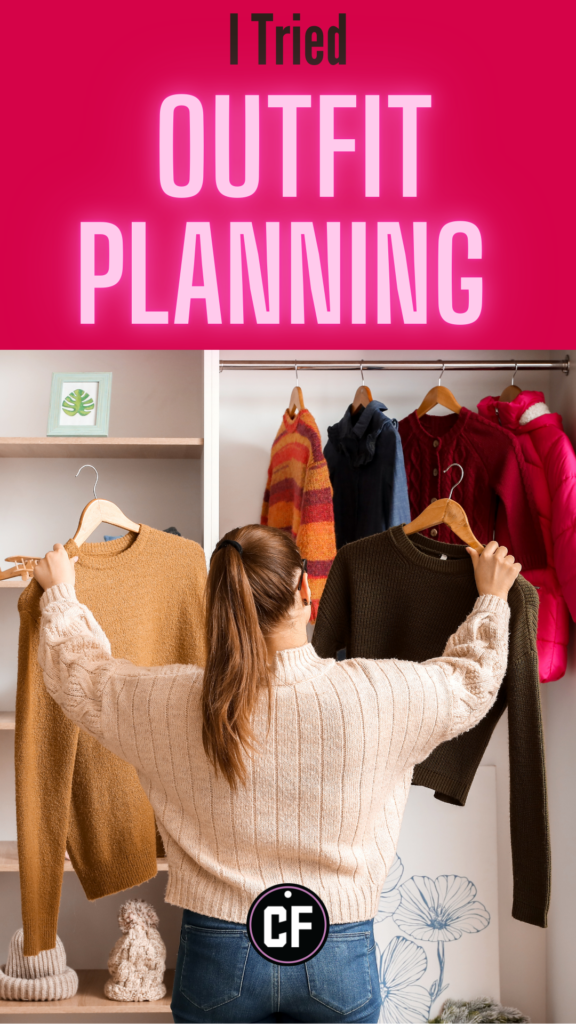
This week, I’m giving you a deep dive into my experience planning my outfits and how you can do it, too.
It’s resolution season, and with a new year comes a chance to start fresh, particularly with your closet.
Maybe you do a winter cleaning and make space for new items or mournfully see the one item that still has the tags on and you haven’t worn all year.
Our closet impacts our lives directly. It can be one of our greatest allies or our biggest financial foe, and addressing it in the new year can be life-changing.
For this post, I’ll tell you how planning my weekly outfits for six months helped me save money, simplify my life, and gain a greater appreciation for my own personal style.
Interested in trying this yourself in the new year? Read on for all the details!
Table of Contents
What is Outfit Planning?
Outfit planning is precisely what it sounds like: deciding in advance what you want to wear on any given day.
We actually do this more often than we think, especially for special occasions. We also do it casually. Some people lay out their outfits for the next day before going to sleep and choose what they’re wearing before going on a plane or before an important meeting or interview.
It is a present-yet-dismissed area of our daily styling.
My Life Before Outfit Planning
I’ve known for a while that I spend too much money on clothes, but it hit a new high in early 2024.
Over the past year, my weight has fluctuated, and it soon became apparent that much of what was in my closet either didn’t fit me or had stopped looking as good on me as it used to.
Opening my closet to get dressed in the morning got overwhelming and frustrating. I had too many clothes. So many things didn’t fit, and others weren’t comfortable anymore. Honestly, I couldn’t even remember most of the things I had.
Shopping and sewing soon became a crutch—an expensive one. Whenever I couldn’t figure out what to wear, I either bought or made something new to freshen up my closet, which only added more clutter and didn’t fix the problem.
Then, something finally pushed me to change how I dealt with my closet.
I left my previously 100% remote job for a better, more stable one that required me to go to the office three days a week. For the first time in almost six years, I had to consider the space and environment of an office.
I work in tech, so the dress code is almost non-existent, though obviously, whatever I wear has to be office-appropriate. But within my office attire, I wanted to still dress like me: colorful, put together, and a bit eclectic.
Before I started my new job, I decided to plan my outfits for that week, just to take that pressure off as I adjusted to my new role. It went so well, and I wore more items in my closet than I had all year. I also felt more creative and inspired by it.
So, I decided to plan my weekly outfits for the next six months.
How I Planned Outfits: Goals and Guidelines
I had two goals with my outfit-planning experiment:
- Make life easier – I wanted to take the pressure off getting dressed in the mornings and focus on other things.
- Maximize and minimize – I wanted to maximize the use of the items in my closet and minimize the money I spent and the frustration I felt.
Then, I created a couple of ground rules to really give this a chance and make this work toward my goals:
- Always start with: What are my activities for each day? – Maybe it was an office day, or I had an event after going to the office, etc. This would be my first consideration.
- Neglected items – Each week, I vowed to list at least three items I hadn’t worn in a while and style them through the week. I wanted to see if they still fit, if I still liked them, and/or if they still worked for my style.
- Items I wanted to wear – Maybe I had a brand new thing I wanted to wear for the first time or a specific item I really wanted to focus on. I would make a note of that when planning for the week.
- Flexibility – I gave myself space to move things around in case things came up during the week, like events, weather, comfortability, etc.
- Take a picture of every single outfit – Because I knew I wanted to write about it for CF, but also because I wanted to be able to reference what worked and what didn’t work for the future.
How Outfit Planning Changed the Game: A Case Study
So, I planned my weekly outfits for six months. I went through almost half a notebook’s worth of annotations and penciled-in ideas. In numbers, we’re talking about 25 weeks and about 180 outfits, give or take. That’s a LOT to go through in one post.
Luckily, I had a trip in late November and early December with only one medium suitcase at my disposal. It was 12 days, so I decided to make this trip my case study for this blog post’s purposes. Again, I would plan every outfit down to the accessories.
Basically, I would apply everything I learned over the past couple of months.
A Trip’s Worth of Outfits
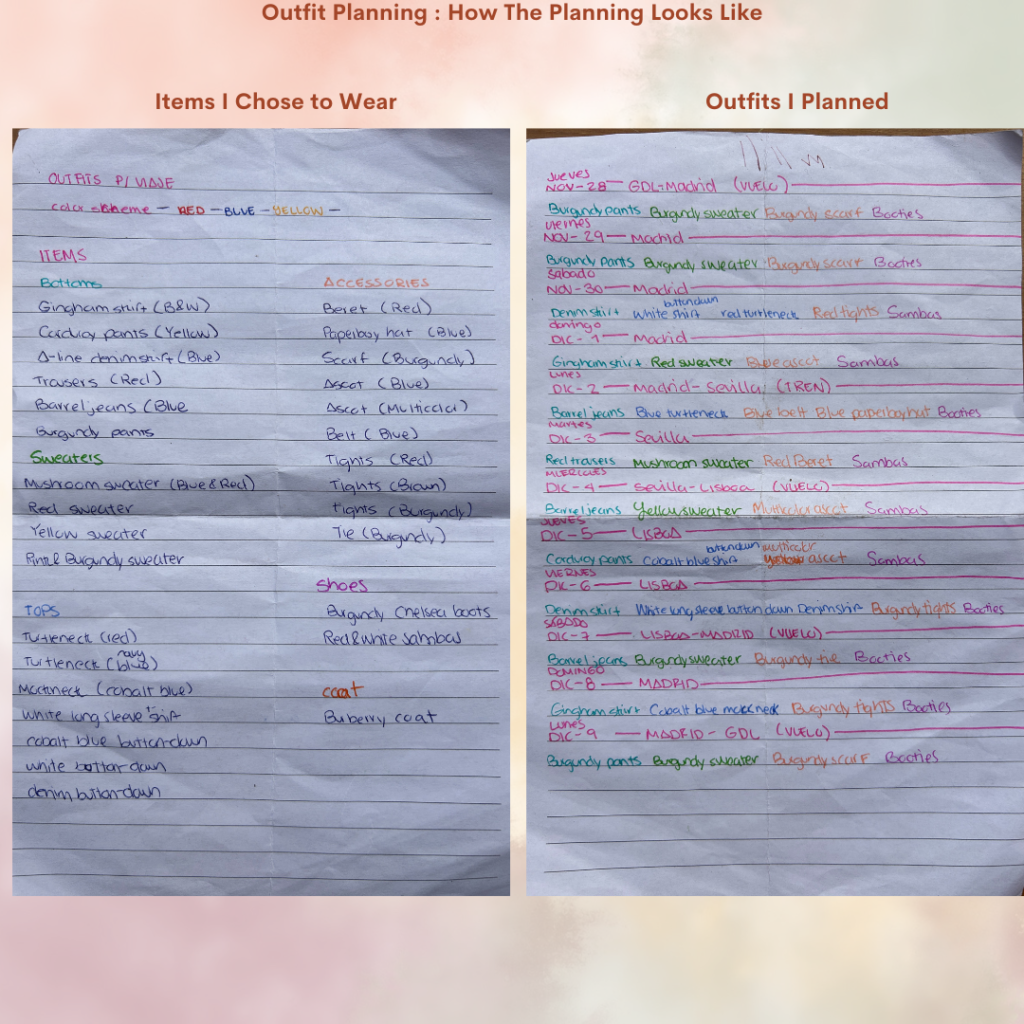
Week #1 (November 28th– December 4th)
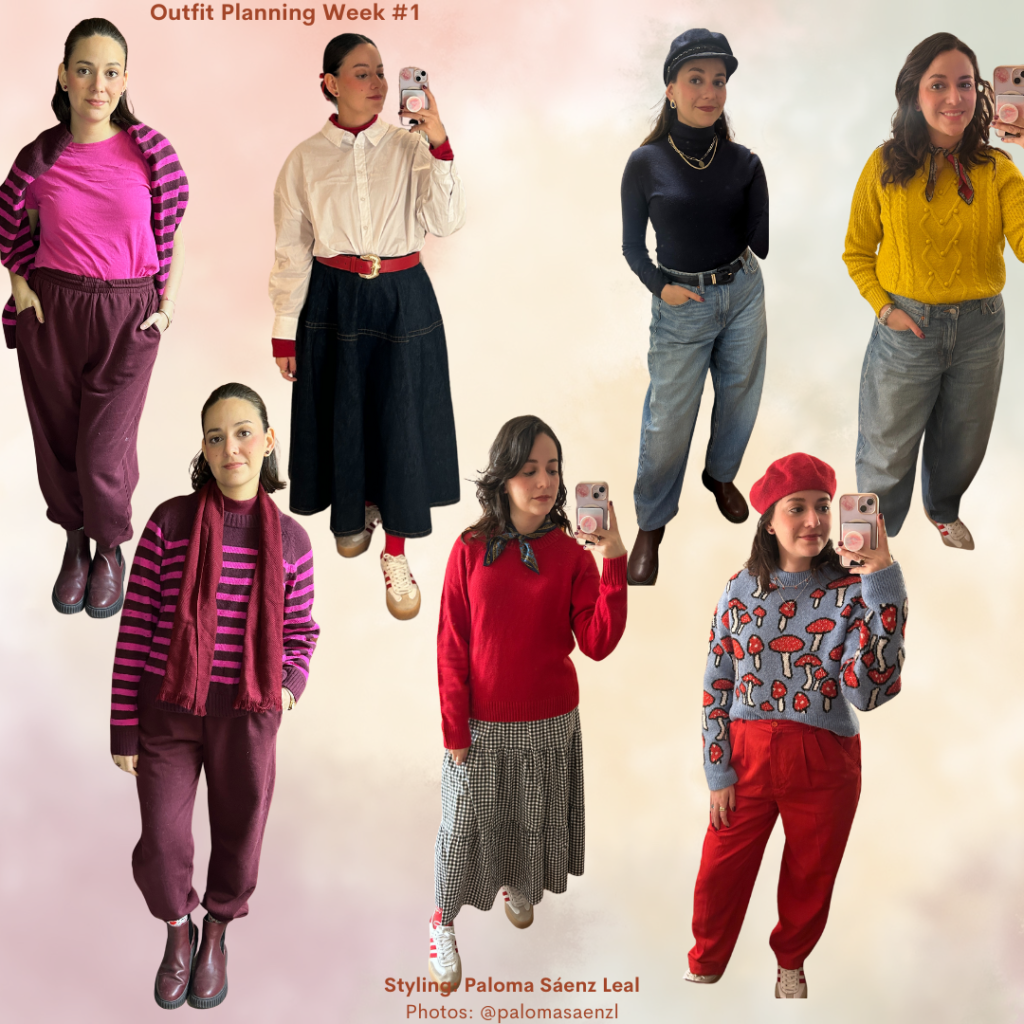
For the first week of the trip, I had six outfits in total, three of which were for days I was traveling.
The first look, a full-burgundy ensemble (bottom and top left), is both my first- and second-day outfit since I lost half a day while flying because of the time difference. I arrived so early that I couldn’t check in at the hotel and didn’t want to open my full suitcase. But I had planned for this, so I had a change of shirt, makeup, deodorant, toothbrush, accessories, and a hairbrush in a backpack.
The first thing I noticed after wearing the outfits I had planned was the relief I felt at the end of a long, tiring, but fun day. I didn’t have to think about what to wear the next day or wake up earlier to create a look. Every night I just read my paper with my outfits, took out what I needed for the next day, everything else went back into the suitcase, and just relaxed afterwards.
There was not a day in which it wasn’t more efficient to just have it already planned out.
Lesson: Learn your Colors
Through the six months of planning my weekly looks, I noticed that my favorite colors differed from the colors I *actually* wore the most.
For example, my absolute favorite color is pink, but I wear red more often and have many more red items in my closet than pink.
I soon realized I would wear an item more often if it was red, blue, or green.
Based on this, I chose a cohesive, three-to-four-color palette to take on my trip. I chose primary colors (red, blue, and yellow) with black and white as neutrals.
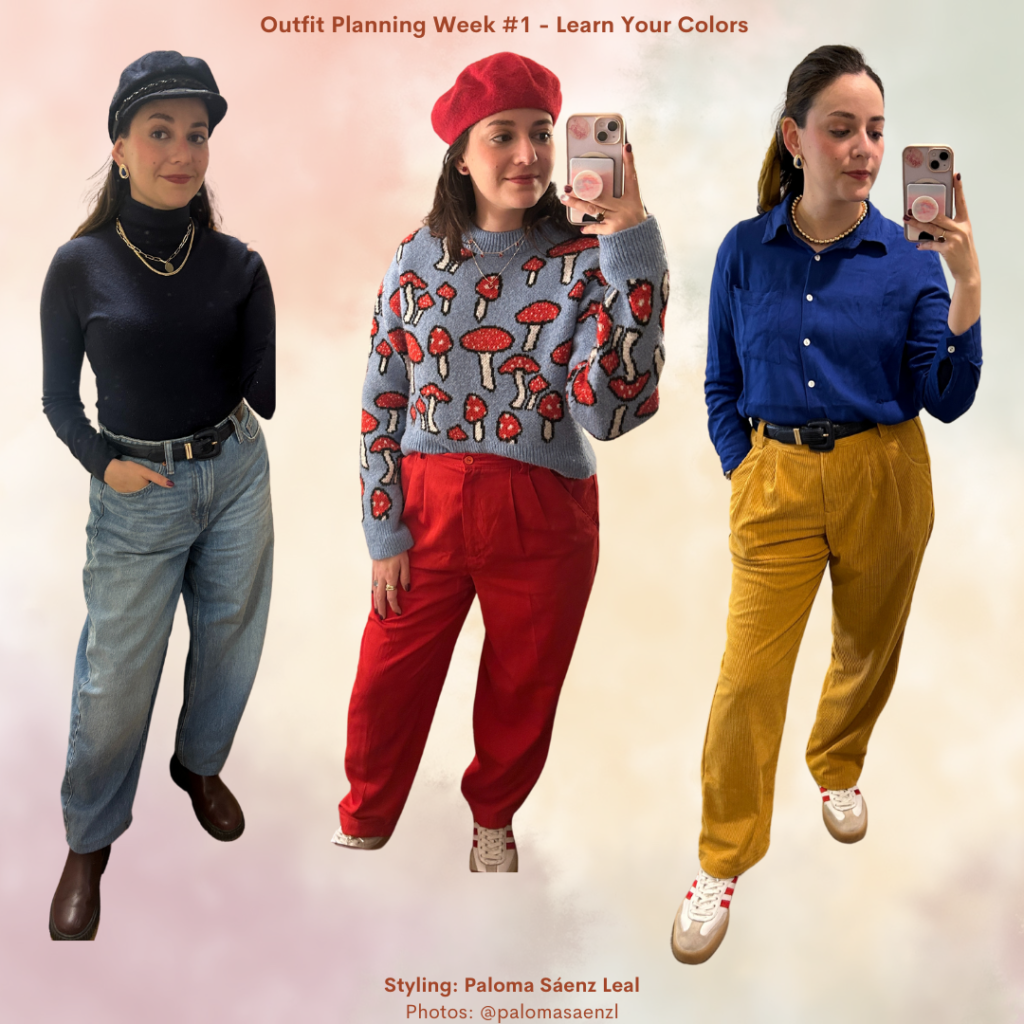
I chose these three colors because I knew I was most comfortable in either red or blue, and yellow is a natural color to pair them both with to create put-together, eclectic, cute looks.
You can see this perfectly in the tops I chose for these three outfits. They’re practically the same look: a pair of loose-fitting pants, a comfy, colorful top, and accessories. But I knew they would work, and I’d be comfortable no matter what because I knew these were the colors I gravitate towards the most.
Lesson: Learn Your Fit
Another thing that became apparent while planning my daily outfits was precisely what types of silhouettes and fits I gravitate toward the most.
For bottoms, I prefer an A-line, barrel, or straight fit, mostly in long skirts, jeans, or tailored trousers. For tops, I use more anything oversized, menswear-inspired, below the waist, or with a high, round neck.
This knowledge narrowed down the items I would consider while planning my trip outfits. I ended up choosing two A-line long skirts, two pairs of straight-fit trousers, and a pair of barrel jeans. For tops, I took two turtlenecks, one mock neck top, three button-down shirts, and one round neckline top.
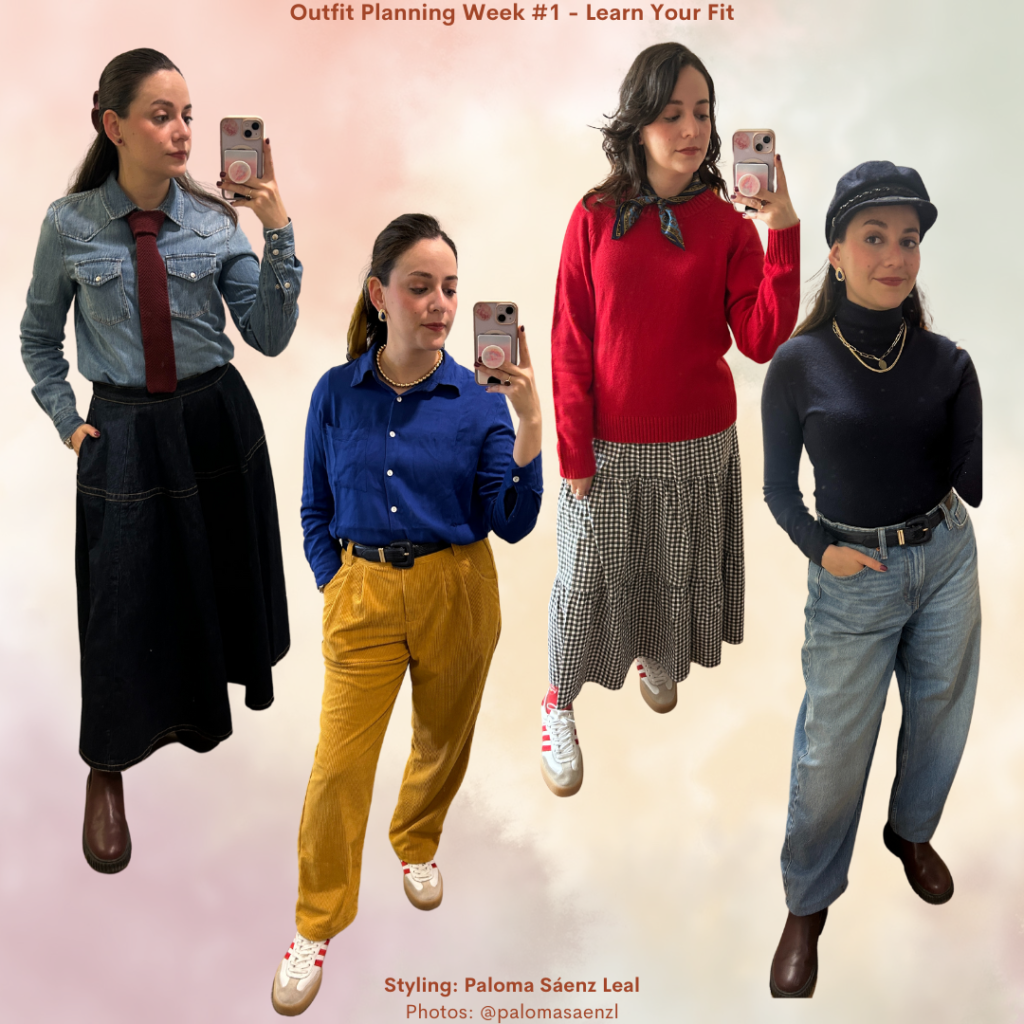
Again, you can see in these four looks all the elements I know I love: menswear, tailoring, comfortable tops, loose-fitting pants, and A-line skirts.
Week #2 (December 5th– November 9th)
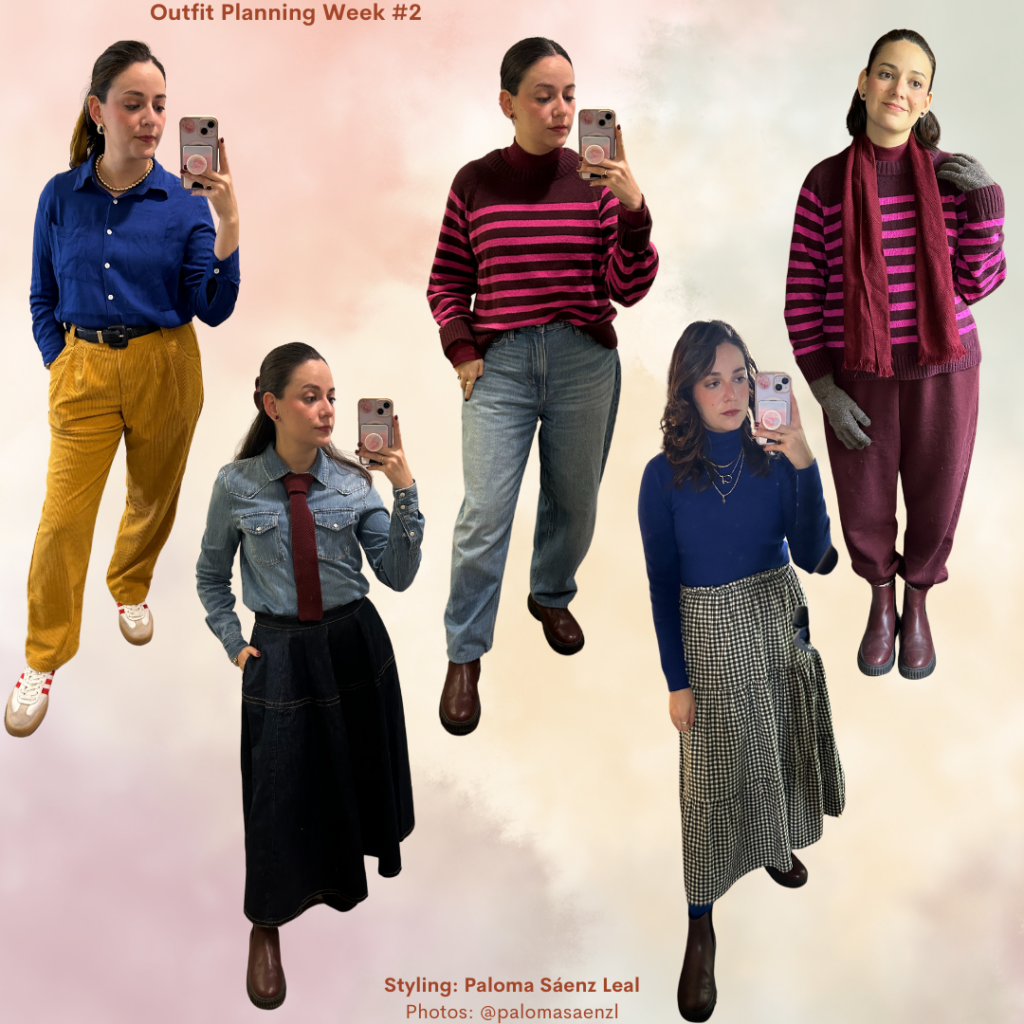
The following week wasn’t a full 7-day week, but I’m still counting it. Two out of five looks were for traveling, and the last outfit was once again the full-on burgundy ensemble from the first two days.
This second week, I noticed how much faster I could pinpoint exactly what wasn’t working in an outfit and how to improve it.
This week, I realized how clear my style had become. I bought a few things while on my trip, and seeing how much less I bought was eye-opening. I knew not only what would work well with what I had but exactly what was missing from my closet and what these new items would be replacing.
It was an amazing feeling just to know how these things blended with everything I had back home based on what I took. Goodbye, buyer’s remorse!
Lesson: Learn to Pivot
While my planned outfits usually worked out, I allowed myself to change my mind if my activities changed or something didn’t go according to plan.
The looks I planned for every week were a healthy mix of casual and put-together. So, for example, I’d be able to change the casual Wednesday outfit for the put-together Saturday outfit as needed.
Most of the time, changes occurred because an event or meeting came up that required a more put-together outfit. But sometimes, it was because an item simply didn’t work out. Maybe the jeans I chose wouldn’t go past my thighs that day, or the skirt and top didn’t actually go together like I had envisioned.
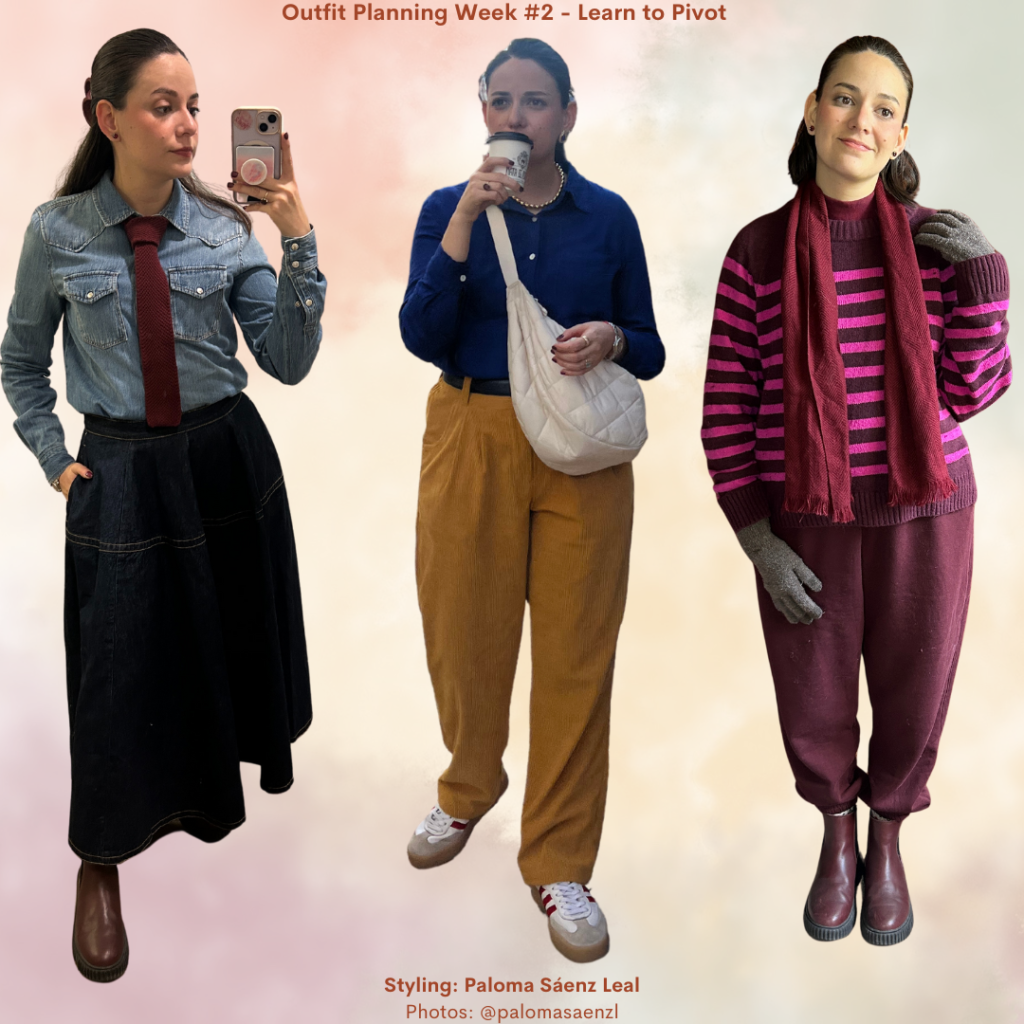
During the trip, there were three instances in which I had to pivot to make the outfits work for me. One was very simple: I didn’t plan on wearing the burgundy tie with the all-denim outfit, and I decided it would look better with that one than the other outfit I had planned for.
The other instance was a bit more challenging to solve. Since it was a trip where I would spend a lot of time outside the hotel, I took a backpack instead of a purse. By day two of the trip, I realized that my backpack was uncomfortable, and I didn’t like how it affected my outfit in general. On day three, I bought an off-white crossbody bag to use during the day and left the backpack for traveling days only.
Finally, it got too cold, even more than I had planned for (I wore thermals and tights underneath on the coldest days). So, I finally caved in and bought and wore gloves for the last two days. They weren’t a stylistic choice but a practical one that really made my day more comfortable.
Lesson: Learn Your Style
Finally, the past six months helped me to really nail down my personal style.
For the past four years, I’ve been drawn to maximalism, but when applying it fully to my looks, it didn’t feel completely right. I’ve been bouncing around trying to make maximalist, eclectic, girly, preppy, comfy styles work together.
By planning my looks, I could finally pinpoint what I liked about each of those styles, what worked for *me*, and what things I liked in theory but didn’t really like in practice.
Since I could only wear what I had in my suitcase for two weeks, I had to ensure that whatever I took and wore would be *me*. I just wanted to be as comfortable and happy as possible without having an ill-fitting pair of pants or a too-tight sweater in the back of my mind.
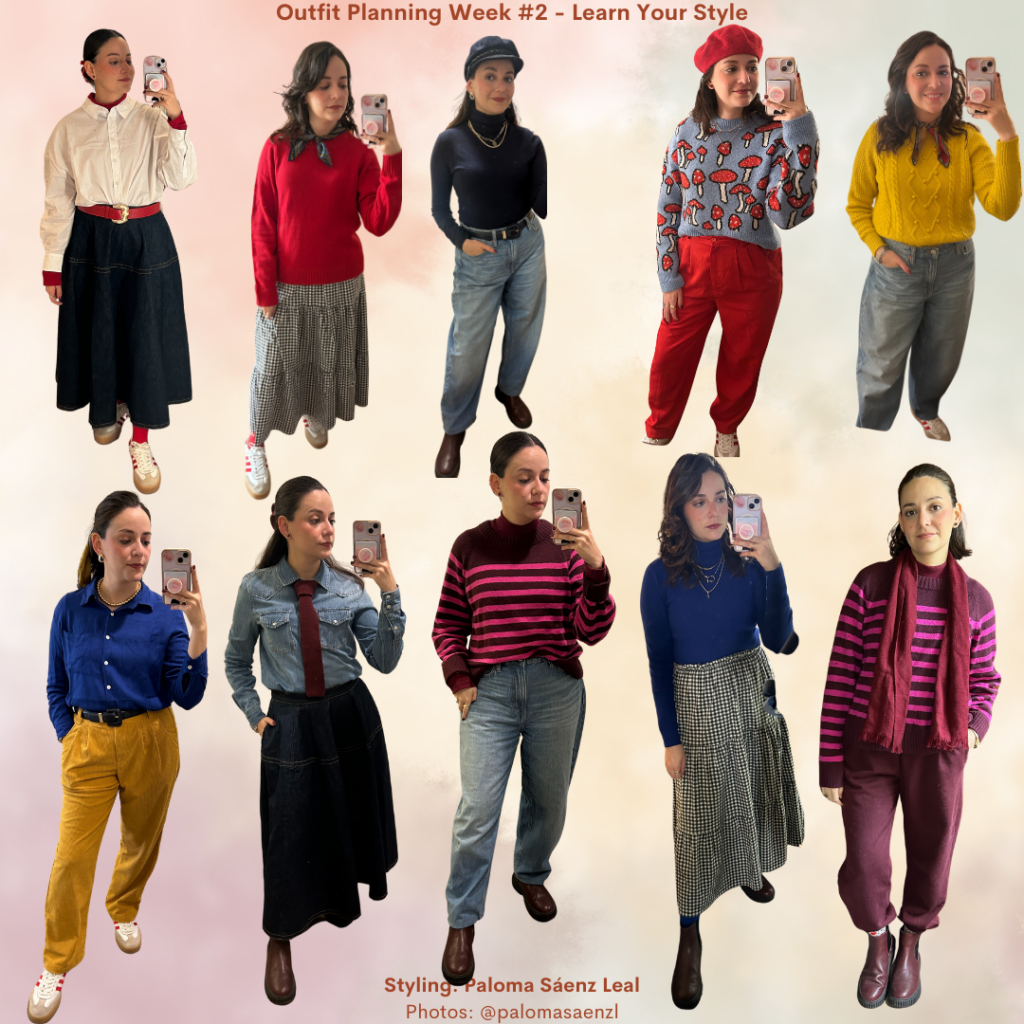
I can say confidently that every single look I wore during this trip was my personal style distilled to perfection.
All of it represented how I dress, but more importantly, how I want to dress daily. The outfits combined layering, fun patterns, menswear-inspired items, oversized coats and sweaters, colorful clothes, and comfortable elements.
Final Thoughts
In general, outfit planning is something that we can all benefit from. It will give you a more complete picture of your closet and style. Plus, it will cut down on your stress and those “I have nothing to wear” moments.
The first thing I noticed from this experiment is that my spending gradually decreased. I stopped before hitting the ‘Buy Now’ button, looked at my planned outfits, then looked at my closet and checked if I had an alternative in it.
I think I’ve managed to cut my shopping in half. Baby steps.
At the end of my six-month experiment, I finally made a major closet declutter. It was easy since I already knew what I was not wearing, what was just not my size anymore, and what didn’t fit with my style. I took out about two-thirds of my closet.
Still, I have a lot of clothes, and I think I’ll keep editing what I have through the following months. Now, I can *actually* see what I have, and I’m sure everything is at least the right size. The most exciting thing was seeing neglected items surprise me and return to the worn rotation.
Going forward, I will keep planning my weekly looks with almost the same guidelines because it has changed my routine for the better.
These past six months have been life-changing for me, not only because of the outfit planning or the new job. I’ve had to make some major lifestyle adjustments, and it resulted in a lot of stress, anxiety, and fear.
I had already been planning my outfits for four months when my life circumstances changed, so I just kept outfit planning as a part of my new routine. It wasn’t until now that I realized how much it helped me organize when everything seemed more uncertain. In the final months of this experiment, I was planning my outfits and annotating doctors’ appointments right beside what accessories or pants I was going to wear.
In a weird way, outfit planning also grounded me. It helped me ease my mind for at least half an hour a week. Now, I’m adjusted to my new routine, and I’m so much better, physically and mentally.
When you make the time to sit down in advance and think about what you’re going to wear, you also run through what you have and what items you prefer with a clearer head. Since you don’t have the clock ticking, you can take your time to make any number of outfit combinations until you find the right one. It gives you space for mistakes or adjustments without feeling the frustration of “I need to leave in 10 minutes”.
I would recommend outfit planning if you’re feeling frustrated or overwhelmed with your closet while you get dressed, if you’re worried you’re spending too much on clothes and still cannot seem to find something to wear, or if you have an important week ahead of you. It will help you focus better and see what it is about your closet that is or isn’t working.
I hope it changes your life like it did mine!
What Do You Think?
Would you try planning your outfits? Do you do it now? Do you have any styling questions? Let us know in the comments below!
